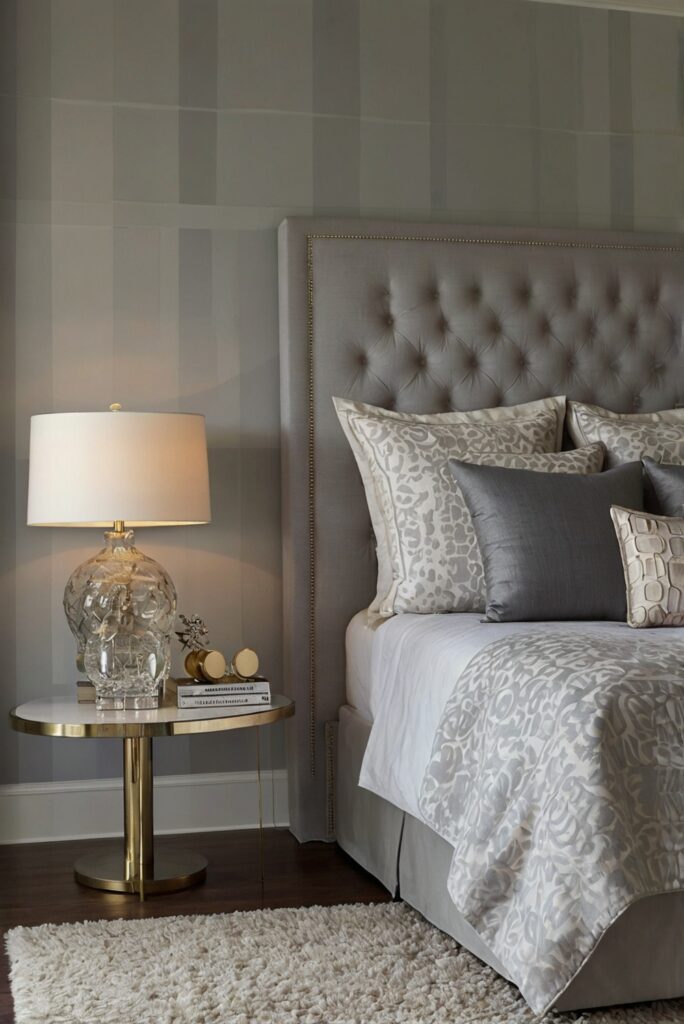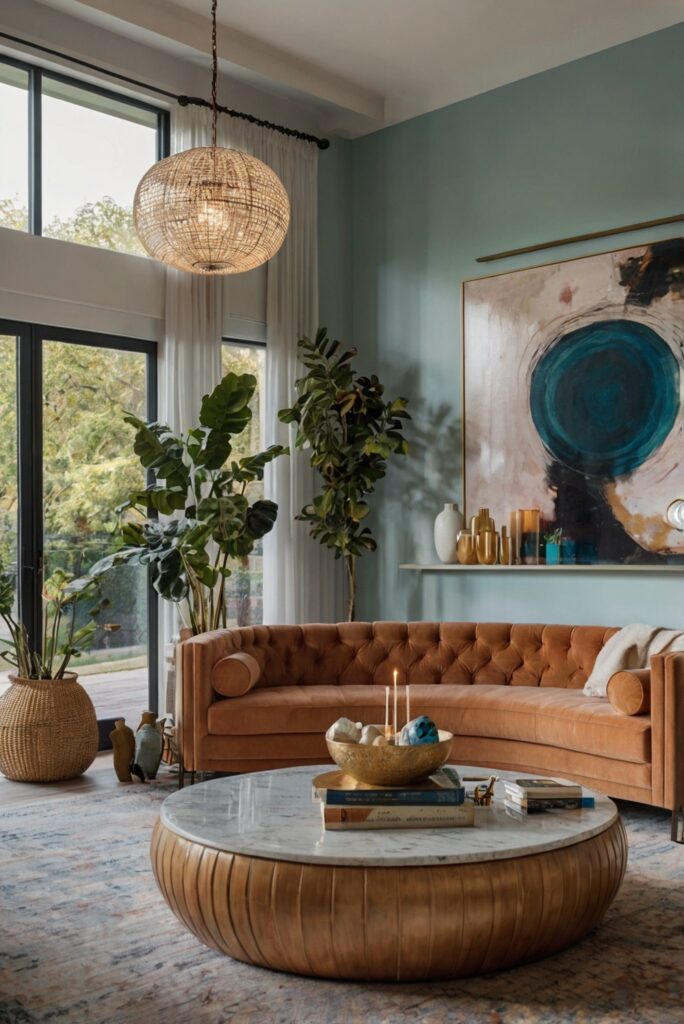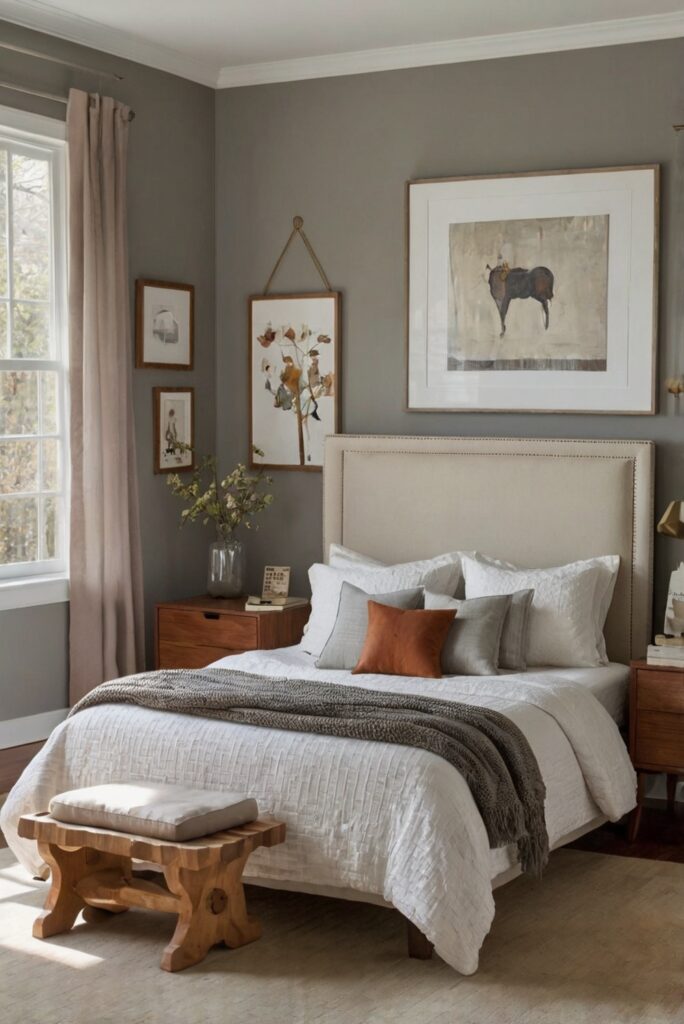In this daily routine for interior designers, learn how to use paint to transform your bedroom with a striking feature wall behind your bed. Elevate your space effortlessly.
To use paint to create a feature wall behind your bed as part of your home decorating routine, start by choosing a color that complements the rest of the room’s decor. Consider using a bold color or a different shade of the existing wall color to create a focal point. Prepare the wall by ensuring it is clean and smooth, then apply a primer paint for walls to ensure better adhesion and color consistency. Use a high-quality paint and consider color matching painting to achieve a seamless look. Make sure to use painter’s tape to create clean lines and protect adjacent walls. Allow the paint to dry completely before moving furniture back into place. This simple home decor interior design project can instantly transform the look of your bedroom with minimal effort.
Choose the Right Color:
When creating a feature wall behind your bed, the first step is to choose the right color for the paint. The color you select will set the tone for the entire room. Consider the overall color scheme of your bedroom and choose a color that complements it. Bold and vibrant colors can make a statement, while soft pastel shades can create a calming atmosphere. Take into account the natural light in the room as well, as this can affect how the color appears.
Prepare the Wall:
Before you start painting, it is essential to prepare the wall properly. This includes cleaning the wall to remove any dirt, dust, or grease that may affect the paint’s adhesion. Fill in any holes or cracks with spackling compound and sand the wall smooth. Use painter’s tape to protect the adjacent walls, ceiling, and baseboards from paint splatter. A well-prepared wall will ensure a smooth and professional finish.
Prime the Wall:
To ensure the paint adheres properly and achieves the desired color, prime the wall before painting. Primer helps seal the wall and provides a smooth surface for the paint to adhere to. It also helps prevent the original wall color from bleeding through. Choose a primer that is suitable for the type of paint you will be using. Apply the primer evenly and allow it to dry completely before proceeding with the paint.
Apply the Paint:
Once the primer is dry, it’s time to apply the paint to create your feature wall. Use a high-quality paint that is appropriate for the surface you are painting. Consider using a satin or semi-gloss finish for easy cleaning and durability. Start by cutting in the edges with a brush and then use a roller to fill in the rest of the wall. Apply the paint in thin, even coats to prevent drips and achieve a smooth finish. Allow each coat to dry before applying the next.
Add Texture or Patterns:
To make your feature wall truly stand out, consider adding texture or patterns to the painted surface. You can use techniques like sponging, rag-rolling, or stenciling to create interesting textures and designs. These techniques can add depth and visual interest to the wall, making it a focal point in the room. Experiment with different patterns and textures to find a look that complements your bedroom decor.
In conclusion, creating a feature wall behind your bed using paint can transform the look and feel of your bedroom. By following these steps and tips, you can achieve a stunning feature wall that enhances the overall design of your room. Remember to choose the right color, prepare the wall properly, prime the surface, apply the paint carefully, and consider adding texture or patterns for a unique touch. With a little creativity and effort, you can turn your bedroom into a stylish and inviting space.
1. How do you choose the right color for a feature wall behind your bed?
To choose the right color for a feature wall behind your bed, consider the overall color scheme of your bedroom. Opt for a color that complements the existing decor and creates a cohesive look. Neutral shades like gray, beige, or white are versatile options that can work well with various styles. Alternatively, you can experiment with bold colors like navy blue, emerald green, or deep burgundy to make a statement.
2. What type of paint finish is best for a feature wall behind your bed?
For a feature wall behind your bed, consider using a paint finish that adds depth and visual interest. Satin or eggshell finishes are popular choices as they offer a subtle sheen that enhances the wall without being too glossy. Matte finishes can also work well, providing a soft and sophisticated look that won’t reflect too much light.
3. How can you create a sense of texture on a feature wall behind your bed using paint?
To create a sense of texture on a feature wall behind your bed, consider using techniques like color washing, sponge painting, or rag rolling. These methods can add depth and dimension to the wall, making it more visually appealing. You can also use stencils or painter’s tape to create geometric patterns or stripes for a modern look.
4. What are some creative ideas for designing a feature wall behind your bed with paint?
Some creative ideas for designing a feature wall behind your bed with paint include creating a gradient effect using different shades of the same color, painting a mural or abstract design, or adding metallic accents for a touch of glamour. You can also experiment with patterns like chevron, herringbone, or ombre for a unique and personalized look.
5. How can you ensure a professional-looking finish when painting a feature wall behind your bed?
To ensure a professional-looking finish when painting a feature wall behind your bed, start by properly preparing the surface by cleaning and priming it. Use high-quality paint and tools to achieve smooth and even coverage. Take your time and work in small sections, allowing each coat to dry completely before applying the next. Use painter’s tape to create clean lines and edges, and touch up any mistakes with a small brush. Finally, step back and assess the overall look to make any necessary adjustments.



